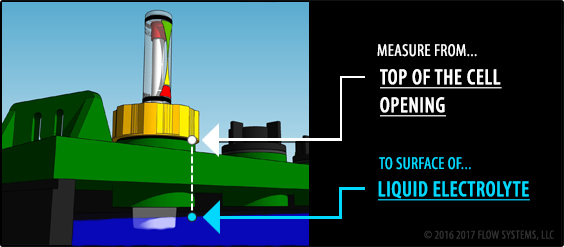You have two options for determining which Battery Water Level Indicator you need for your specific make and model of battery.
1) Measuring your batteries Water Reserve Capacity
Start by making sure you always have the proper safety equipment when working with any battery. In addition to gloves and goggles, you will need some type of device to measure the level of water inside the battery. Wood items like a chop stick, wooden Popsicle stick or food testers work best.

Remove the existing vent caps from your battery. Check to make sure the internal plates are covered by at least 1/4" of water, then charge your battery. Never fill your battery all the way with water prior to charging in order to avoid an overflow of electrolyte (Water + Acid). Electrolyte in your battery will expand once the battery begins to generate heat during charging. If the battery is already at capacity, water will be forced to escape through the vent which can cause a potentially dangerous situation due to the caustic nature of the sulphuric acid. So remember, put water into your battery after the charge cycle.
Once the batteries have been sufficiently charged, add enough water to bring the level up to approximately 1/4" below the vent well. The vent well is the tube that you look through to determine your batteries water level. Once your battery is at the correct level, insert your measuring device down into the cell being careful to only touch the tip of the measuring device to the very top of the water.
Next, hold the measuring device against the side wall of the vent well. Take a pen or pencil and mark the measuring device right at the spot where it reaches the top of the vent well. Essentially, you are measuring from the water's surface when filled to the very top of the vent well or the cell opening. A flash light may help when trying to see into the vent well.
Now take a ruler or measuring tape and measure from the mark you just made down to the bottom of the measuring device.
Alternatively, you can measure to the bottom of the battery vent well and add 1/4" to the total. Both should give you the same result.
Finally, select the Battery Water Level Indicator above whose fill height most closely matches the fill height of your specific battery to within 1/4".
2) Contacting the Battery Manufacturer
If you still have the maintenance manual that came with your battery, chances are it will contain the fill height or as it is often referred to as the "Water Reserve Capacity" of your battery. Most battery manuals can still be found online listed on the manufacturer's website.
Please note that all batteries, even in the same group size do not necessarily have the same water reserve capacity. Reserve capacity water levels vary greatly, so be sure to determine the correct water level reserve capacity for your specific make and model.
If you no longer have the maintenance manual that came with your battery, then it is time to call the manufacture. Make sure to right down the Model # of your battery prior to calling.
If you still have questions, feel free to contact us at any time at (419) 290-1103.
|